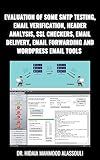Best SMTP Tools to Buy in December 2025
To send SMTP mail with command prompt, you need to have access to a command prompt or terminal window on your computer. First, open the command prompt and type in the command "telnet smtp.yourmailserver.com 25" where "yourmailserver.com" is the address of your SMTP server.
Once you have connected to the SMTP server, you can start sending the email using the following commands:
- Type "HELO yourdomain.com" to identify yourself to the server.
- Type "MAIL FROM: sender@example.com" to specify the sender's email address.
- Type "RCPT TO: recipient@example.com" to specify the recipient's email address.
- Type "DATA" to start composing the email message.
- Type the email subject and body, followed by a period (.) on a new line to indicate the end of the email message.
- Type "QUIT" to close the connection to the SMTP server.
Make sure to replace the placeholders (yourdomain.com, sender@example.com, recipient@example.com) with the actual values of your email addresses. It is also important to ensure that your SMTP server allows sending emails through telnet before attempting to send the email.
How can I format the email content properly when sending it via SMTP in the command prompt?
When sending an email via SMTP in the command prompt, you can format the email content properly by following these steps:
- Start by establishing a connection to the SMTP server using the telnet command: telnet smtp.server.com 25
- Once connected, you will need to introduce yourself to the server by typing: HELO yourdomain.com
- Next, specify the sender's email address by typing: MAIL FROM: sender@example.com
- Specify the recipient's email address by typing: RCPT TO: recipient@example.com
- Begin the data entry by typing: DATA
- Enter the email subject by typing: Subject: Your email subject
- Add a blank line to separate the subject from the email body:
- Enter the email body content, ensuring to follow proper email etiquette and formatting such as using paragraphs, bullet points, and proper spacing.
- Once you have finished writing the email content, end the message by typing a period (.) on a line by itself: .
- To close the connection and send the email, type: QUIT
By following these steps, you can format the email content properly when sending it via SMTP in the command prompt.
How to send a test email through SMTP from the command prompt?
To send a test email through SMTP from the command prompt, you can use the telnet command. Follow these steps:
- Open the command prompt on your computer.
- Type the following command and press Enter:
telnet smtp.yourmailserver.com 25
Replace smtp.yourmailserver.com with the SMTP server address provided by your email service provider.
- You should see a response from the SMTP server. If the connection is successful, you can proceed to send the email.
- Enter the following commands to generate a test email:
HELO yourdomain.com MAIL FROM: your@email.com RCPT TO: recipient@email.com DATA Subject: Test Email This is a test email sent through SMTP. . QUIT
Replace yourdomain.com, your@email.com, and recipient@email.com with your domain name, email address, and recipient's email address, respectively.
- Press Enter after each command, and make sure to end the email body with a period . on a new line. This tells the SMTP server that the email message is complete.
- If you receive a "250 OK" response after sending the email, it means the test email was successfully sent.
Note that some SMTP servers may require authentication before sending an email. In that case, you would need to include the AUTH command and provide the necessary credentials. Check with your email service provider for additional instructions on using SMTP through the command prompt.
What is the recommended format for the email subject line when sending it through SMTP in the command prompt?
The recommended format for the email subject line when sending it through SMTP in the command prompt is:
Subject: [Your subject here]



